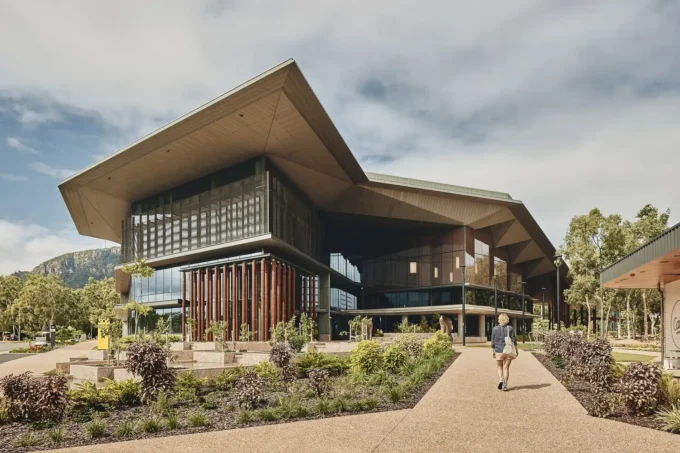Concordia University of Edmonton (CUE) has always stood out as a place where personal connection meets global aspiration. With a mission rooted in academic freedom, ethical leadership, and scholarly integrity, the university offers a boutique educational experience while keeping sight of international relevance. Reflecting this dual identity, Braaksma Hall, the university’s newest academic building, is more than an institutional facility—it is a bold architectural statement that bridges tradition with innovation.
Designed by Reimagine Architects Ltd., Braaksma Hall officially opened in Fall 2024 as a forward-looking, sustainable, and inclusive learning environment. The building is a key component of CUE’s long-term strategy for measured growth, enhancing campus life while respecting the university’s human-scale and community-focused identity.

Architecture Shaped by Community
Contextual Sensitivity and Inclusive Engagement
Early in the design process, Reimagine Architects undertook extensive engagement with the local community. These conversations played a critical role in shaping the architectural form, particularly along the west elevation, which faces nearby residential homes. Rather than imposing on the neighborhood, the design features angled zig-zag walls and south-facing windows that preserve resident privacy while maintaining openness and daylight access.
This sensitivity to context extends throughout the site. Located along 73 Street, near 109 Avenue and Virginia Park School, Braaksma Hall replaces former surface parking with increased green space and public access, reducing environmental impact and enhancing community integration. The result is a project that does not merely exist within a neighborhood but actively contributes to it.

A Dynamic, Multi-Use Academic Facility
Purpose-Built for Evolving Educational Needs
Braaksma Hall spans 5,200 square meters and incorporates a mix of two- and three-storey sections. Designed to accommodate Concordia’s academic growth, the building includes:
-
55 private and shared offices
-
22 breakout rooms for collaborative learning
-
15 flexible-use classrooms
-
3 modern laboratories
-
2 large lecture theatres
-
A two-level underground parkade for 122 vehicles
This versatile programming reflects a deep understanding of academic life. Beyond formal learning spaces, each level includes gathering zones designed to foster informal interaction. On the ground floor, a light-filled atrium featuring polished concrete floors and a suspended mesh ceiling creates a welcoming entrance. Neutral materials provide a flexible canvas for future personalization.
Upstairs, a second-floor common area offers a semi-private, lounge-like setting defined by natural wood tones and soft lighting. With tiered gathering spaces, expansive curtain walls, and clerestory windows providing abundant daylight, the environment is carefully tuned to encourage community, collaboration, and reflection.
A Commitment to Wellness and Accessibility
Designing for Health, Comfort, and Inclusivity
As a post-pandemic academic space, Braaksma Hall integrates numerous health-conscious design elements. Wider corridors, accessible ramps, and layouts that allow for social distancing are key features that support the well-being of students, faculty, and visitors. Operable windows provide access to fresh air, while strategically placed gathering areas encourage movement and interaction in a safe, comfortable environment.
The building also includes a pedway connection to adjacent campus facilities, ensuring weather-protected access during harsh winter months. This feature aligns with best practices for cold-climate campus planning and eases interdisciplinary collaboration, particularly for transporting lab equipment and research materials.

Leading with Sustainability
Engineering a Low-Carbon, High-Performance Building
Sustainability is embedded into every layer of Braaksma Hall’s design. Working with the Smart Sustainable Resilient Infrastructure Association (SSRIA), the design team developed an innovative curtain wall system that pairs fiberglass frames with vacuum-insulated glazing (VIG). This hybrid solution exceeds building code requirements and significantly improves energy performance—reducing operational greenhouse gas emissions by an estimated 23 tonnes per year.
A one-year monitoring and verification program is currently underway to compare design-stage energy modelling with actual performance, offering an opportunity for ongoing learning and transparency.
Beyond glazing, the building envelope features superior insulation and high-performance wall panels, minimizing mechanical system loads and reducing operational costs. A mix of black finishes, wood veneer, and a herringbone pattern offers a seamless transition between exterior and interior surfaces. The roof and stair penthouse, clad in durable black standing seam metal, complete the cohesive and resilient aesthetic.
Architecture as a Catalyst for Learning and Belonging
More than a functional building, Braaksma Hall is a space designed to inspire success and belonging. Every design decision—from daylight access to material selection—was made with the intention of nurturing curiosity, confidence, and collaboration.
As Concordia University of Edmonton continues to grow in both size and reputation, Braaksma Hall stands as a symbol of its evolving identity. It demonstrates how architecture can reflect institutional values, enhance community relationships, and support a sustainable future—while never losing sight of the human experience at its core.
Photography: Cooper & O’Hara
- Academic building with daylight design
- Accessible academic buildings
- Braaksma Hall Concordia University
- Campus planning cold climate
- Community-integrated university design
- Concordia University Edmonton architecture
- Curtain wall innovation architecture
- Educational architecture Canada
- Educational architecture with atriums
- Flexible classroom architecture
- Green campus infrastructure Canada
- Health-conscious building design
- Inclusive learning environment design
- Low-carbon academic building
- Modern academic building design
- Post-pandemic campus design
- Reimagine Architects Braaksma Hall
- Smart Sustainable Resilient Infrastructure Association
- Sustainable university architecture
- Vacuum insulated glazing (VIG) design

































Leave a comment